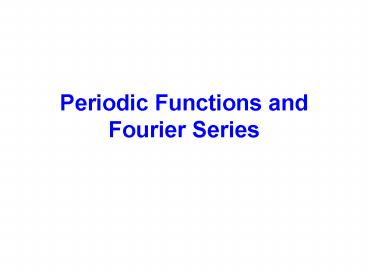Periodic Functions and Fourier Series - PowerPoint PPT Presentation
1 / 81
Title:
Periodic Functions and Fourier Series
Description:
Odd functions can solely be represented by sine waves because, sine waves are odd functions. ... is expressed in terms of a sine series. ... – PowerPoint PPT presentation
Number of Views:625
Avg rating:3.0/5.0
Title: Periodic Functions and Fourier Series
1
Periodic Functions and Fourier Series
2
Periodic Functions
and if there is some positive number,
.
3
(No Transcript)
4
(No Transcript)
5
(No Transcript)
6
Fourier Series
The function can be represented by a
trigonometric series as
7
What kind of trigonometric (series) functions are
we talking about?
8
(No Transcript)
9
(No Transcript)
10
We want to determine the coefficients,
Let us first remember some useful integrations.
11
(No Transcript)
12
(No Transcript)
13
(No Transcript)
14
Integrate both sides of (1) from
15
(No Transcript)
16
(No Transcript)
17
You may integrate both sides of (1) from
It is alright as long as the integration is
performed over one period.
18
(No Transcript)
19
(No Transcript)
20
(No Transcript)
21
Let us do the integration on the right-hand-side
one term at a time.
22
(No Transcript)
23
Therefore,
24
(No Transcript)
25
Let us do the integration on the right-hand-side
one term at a time.
26
(No Transcript)
27
Therefore,
28
The coefficients are
29
We can write n in place of m
30
(No Transcript)
31
Example 1. Find the Fourier series of the
following periodic function.
32
(No Transcript)
33
(No Transcript)
34
(No Transcript)
35
(No Transcript)
36
(No Transcript)
37
Therefore, the corresponding Fourier series is
In writing the Fourier series we may not be able
to consider infinite number of terms for
practical reasons. The question therefore, is
how many terms to consider?
38
When we consider 4 terms as shown in the previous
slide, the function looks like the following.
39
When we consider 6 terms, the function looks like
the following.
40
When we consider 8 terms, the function looks like
the following.
41
When we consider 12 terms, the function looks
like the following.
42
The red curve was drawn with 12 terms and the
blue curve was drawn with 4 terms.
43
The red curve was drawn with 12 terms and the
blue curve was drawn with 4 terms.
44
The red curve was drawn with 20 terms and the
blue curve was drawn with 4 terms.
45
Even and Odd Functions
(We are not talking about even or odd numbers.)
46
Even Functions
The value of the function would be the same when
we walk equal distances along the X-axis in
opposite directions.
47
Odd Functions
The value of the function would change its sign
but with the same magnitude when we walk equal
distances along the X-axis in opposite directions.
48
Even functions can solely be represented by
cosine waves because, cosine waves are even
functions. A sum of even functions is another
even function.
49
Odd functions can solely be represented by sine
waves because, sine waves are odd functions. A
sum of odd functions is another odd function.
50
(No Transcript)
51
Example 2. Find the Fourier series of the
following periodic function.
52
(No Transcript)
53
Use integration by parts. Details are shown in
your class note.
54
(No Transcript)
55
The corresponding Fourier series is
56
Functions Having Arbitrary Period
w is the angular velocity in radians per second.
57
(No Transcript)
58
Now change the limits of integration.
59
(No Transcript)
60
(No Transcript)
61
(No Transcript)
62
Example 4. Find the Fourier series of the
following periodic function.
63
(No Transcript)
64
Use integration by parts.
65
(No Transcript)
66
Therefore, the Fourier series is
67
The Complex Form of Fourier Series
Let us utilize the Euler formulae.
68
(No Transcript)
69
Denoting
70
(No Transcript)
71
(No Transcript)
72
The coefficients can be evaluated in the
following manner.
73
(No Transcript)
74
.
75
(No Transcript)
76
Example 1. Find the Fourier series of the
following periodic function.
77
(No Transcript)
78
(No Transcript)
79
(No Transcript)
80
(No Transcript)
81
(No Transcript)































